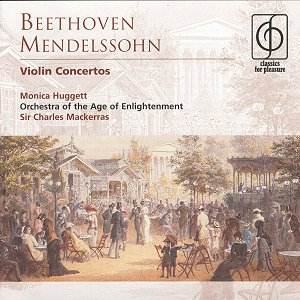Previously available on EMI Eminence, these interesting performances
return in this nicely presented CFP issue, complete with refurbished
sound and the same excellent notes by Wadham Sutton.
Monica Huggett is a violinist who has played an important
role in the development of performing styles appropriate to the baroque
and classical periods. Her performances of these popular concertos confirm
her artistry and her technique, as well as offering many insights into
the music.
A particular feature of both performances is the balance
between solo and ensemble. It seems to be written into the contracts
of many recording artists that concerto performances must feature the
soloist centre-stage in a larger-than-life perspective. That is not
so here, since the balances seem precisely those which one would encounter
in a small to middling size concert hall - the sort of hall that the
composers would surely have had in mind.
Having said that, there is room for a larger-scale
concept than these performances create. If anything the vision here
is under-stated, and many other soloists will give the listener a greater
sense of interpretation and vision. Perhaps the orchestral sound has
something to do with it too. The opening timpani taps in the Beethoven
don't have a particularly pleasing sound, nor does the tutti which follows,
and the ear takes a little while to get used to the 'period' flavour
of the tone quality. Of course this all suits the lighter sound that
Huggett produces, too, but it is not as tonally pleasing as the music
can be.
Once the Beethoven really gets under way - it is, after
all, a big piece - it generates a compelling intensity, and the solo
line is nicely characterised, not least in the fluent music of the slow
movement. Huggett plays her own cadenzas, which are very much in keeping
with the nature of her performance, which brings satisfaction if it
does not uplift the soul.
The Mendelssohn Concerto also starts problematically
before developing a more positive view. Huggett's phrasing of the glorious
tune with which Mendelssohn begins does not quite have the natural flow
the music needs, and the same might be said of the slow movement too.
However, there are many compensations, particularly in the clear articulation
of the faster music. Although one would hesitate to recommend this as
a first choice recording, the performances do have many insights and
abundant interest.
Terry Barfoot


